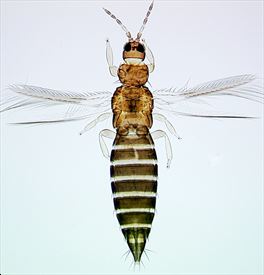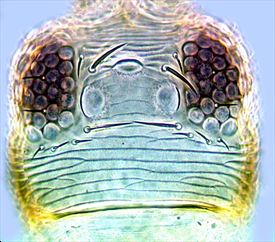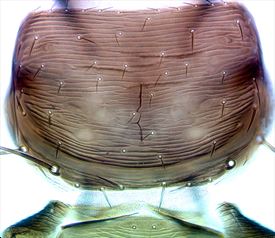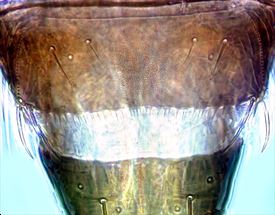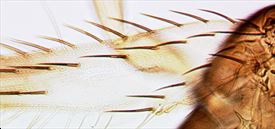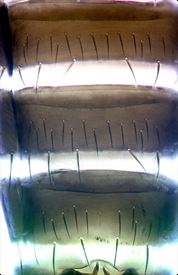Distinguishing features
Both sexes fully winged. Female brown or sometimes bicoloured with abdomen brown and head and thorax orange yellow; antennal segment III yellow; fore wings brown with base paler. Antennae 7- or 8-segmented. Head with ocellar setae III outside ocellar triangle; postocular setae I & II subequal. Pronotum with transverse markings, one pair of midlateral setae stout. Mesonotum with lines of sculpture close to anterior campaniform sensilla. Metanotum transversely striate on anterior half, with longitudinal but more widely spaced striations on posterior half; median setae arise at anterior margin; campaniform sensilla present, rarely absent. Fore wing first vein with 3 setae on distal half; clavus with subterminal seta shorter than terminal seta. Abdominal tergite II with 4 lateral setae; tergite VIII comb complete but short and irregular; pleurotergites with no discal setae. Sternites III–VII with 12–25 discal setae.
Male pale brown, similar in structure to female.
Related species
The genus Thrips includes 13 species from New Zealand, out of a total of 280 species worldwide (Mound & Masumoto, 2005). Many of these species have the antennae clearly 7-segmented, whereas others have 8 segments, but hawaiienis is unusual because the terminal segment is variable. All members of Thrips genus have paired ctenidia on the tergites, and on tergite VIII these are postero-mesad to the spiracles, and they also lack ocellar setae pair I in front of the first ocellus. In contrast, Frankliniella species have ctenidia on tergite VIII antero-lateral to the spiracles, and a pair of setae is always present in front of the first ocellus. T. hawaiiensis is very similar to T. florum (not recorded from NZ), although in that species the subapical seta on the fore wing clavus is longer than the apical seta.
Biological data
This highly polyphagous thrips is found in the flowers of many plants, and is sometimes considered a pest.
Distribution data
This species was recorded from New Zealand by Stannard (1964) on the basis of a single female from Campbell Island. This record is doubtful, as the species is unlikely to survive in New Zealand, and particularly not in the subantarctic islands. It is widespread across Asia and islands in the Pacific, and also found in the southern states of USA, and Jamaica.
Family name
THRIPIDAE, THRIPINAE
Species name
Thrips hawaiiensis (Morgan)
Original name and synonyms
Euthrips hawaiiensis Morgan, 1913: 3
Thrips sulphurea Schmutz, 1913: 1011
Thrips nigriflava Schmutz, 1913: 1012
Thrips albipes Bagnall, 1914: 25
Physothrips albipes Bagnall, 1916: 401
Physothrips pallipes Bagnall, 1916: 400
Bregmatothrips theifloris Karny, 1921: 66
Thrips versicolor Bagnall, 1926: 108
Thrips pallipes Bagnall, 1926: 110
Physothrips emersoni Girault, 1927: 2
Thrips io Girault, 1927: 351
Thrips partirufus Girault, 1927: 1
Physothrips lacteicolor Girault, 1928: 1
Physothrips marii Girault, 1928: 2
Taeniothrips eriobotryae Moulton, 1928: 297
Physothrips mjobergi darci Girault, 1930: 1
Thrips imitator Priesner, 1934: 267
Taeniothrips florinatus Priesner, 1938: 489
Taeniothrips rhodomyrti Priesner, 1938: 492
References
Hoddle MS, Mound LA, Paris DL (2012) Thrips of California2012. CBIT Publishing, Queensland. http://keys.lucidcentral.org/keys/v3/thrips_of_california/
Thrips_of_California.html
Mound LA & Masumoto M (2005) The genus Thrips (Thysanoptera, Thripidae) in Australia, New Caledonia and New Zealand. Zootaxa 1020: 1–64.
Mound LA. & Tree DC & Paris D (2012) OzThrips – Thysanoptera in Australia. http://www.ozthrips.org/
Mound LA & Walker AK (1982) Terebrantia (Insecta: Thysanoptera). Fauna of New Zealand 1: 1–113.
Stannard LJ (1964) Insects of Campbell Island, Thysanoptera. Pacific Insects Monograph 7: 235.

